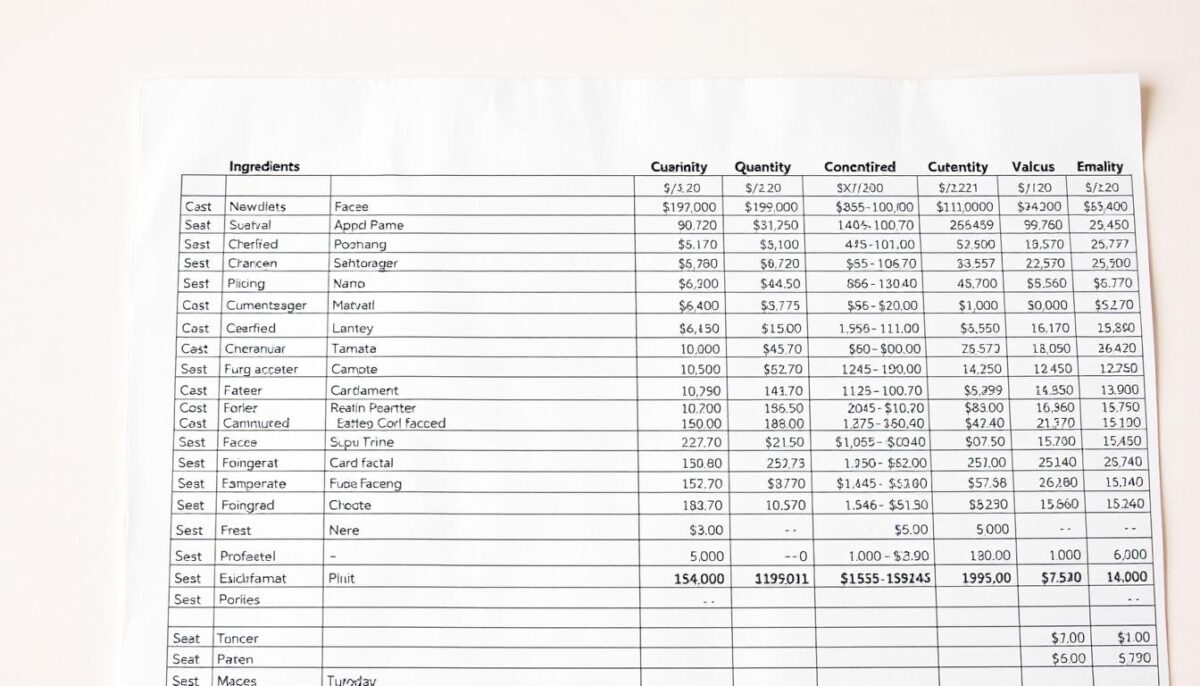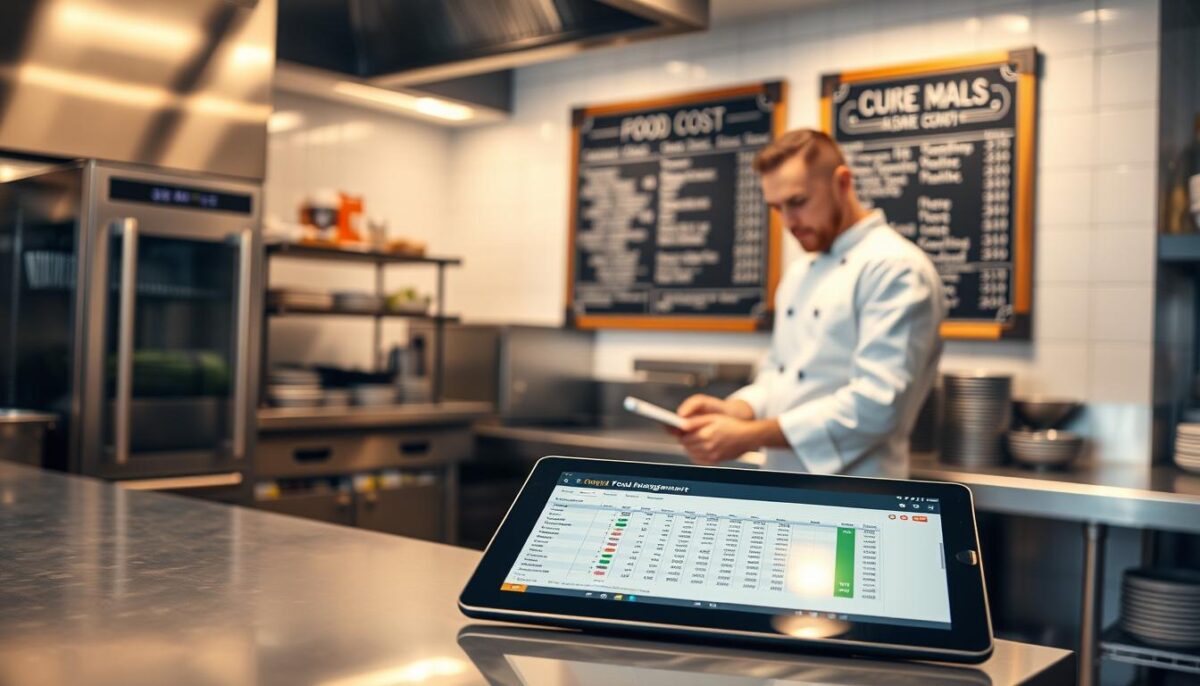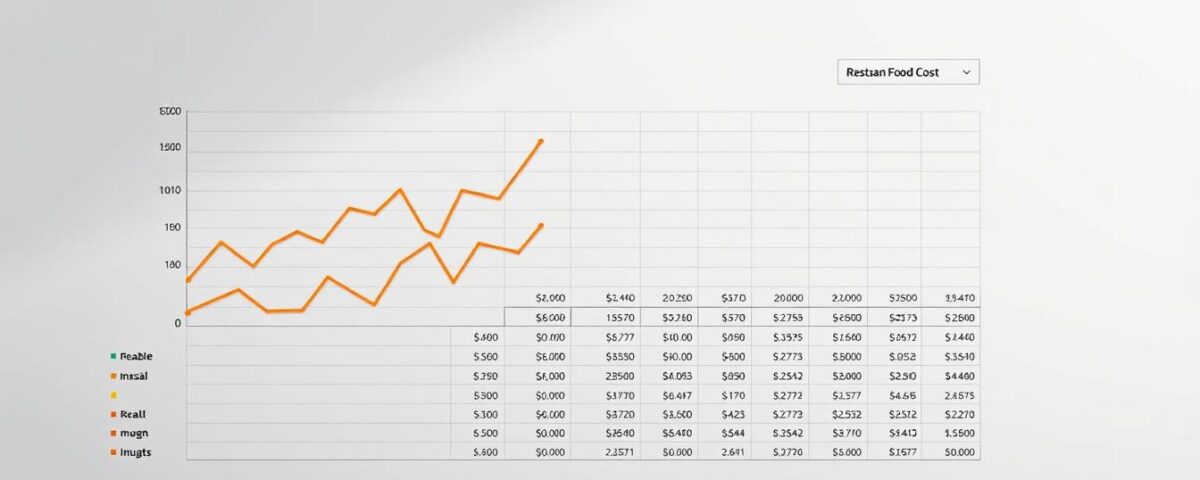
Quick Guide: Vetting Low-Cost Chicken Suppliers Without Risk
August 22, 2025
How to Boost Your Restaurant Profit Margin Above Industry Average
August 22, 2025As a restaurant owner, I’ve seen firsthand how a simple food cost template can transform operations and significantly boost profit margins. Did you know that a 1% reduction in food costs can lead to a 10% increase in profits? With the average restaurant making a net profit margin of around 3-5%, optimizing food costs is crucial.
Managing food costs effectively is key to maintaining healthy profit margins. By implementing a proper cost management system, I can make informed decisions about my menu and pricing, ultimately enhancing my restaurant’s bottom line.
Key Takeaways
- Learn how a food cost template can boost your restaurant’s profit margins.
- Understand the importance of tracking food costs for restaurant success.
- Discover how accurate food costing impacts menu engineering decisions.
- Find out how small improvements in food cost management can lead to significant profit increases.
- Get a practical approach to food cost analysis that doesn’t require advanced accounting knowledge.
Understanding Food Cost Percentages and Why They Matter
Food cost percentages play a significant role in determining the financial health of my restaurant business. Understanding this metric is crucial for maintaining profitability and sustainability.
The Impact of Food Costs on Restaurant Profitability
My restaurant’s profitability is directly affected by food costs. On average, restaurant food costs range between 25% and 32% of total sales. A 1-2% reduction in food costs can translate to thousands of dollars in additional profit annually. This makes monitoring and controlling food costs essential for my business’s financial health.
What Makes Up Your Food Cost Percentage
Several factors contribute to my food cost percentage, including:
- Ingredient costs for menu items
- Waste and inefficiencies in food preparation
- Menu pricing strategies
- Inventory management practices
By understanding these components, I can identify areas for improvement and make data-driven decisions to optimize my menu and reduce costs.
The Essential Components of an Effective Food Cost Template
A well-structured food cost template in Excel can significantly impact your restaurant’s bottom line. By accurately tracking food costs, you can make informed decisions to optimize your menu and improve profitability.

Key Data Points to Track in Your Template
To effectively manage food costs, it’s crucial to track the right data points. The seven essential items of food data you need for precise costing are: Ingredient, Unit, Quantity, Pack Size, Pack Price, Cost per Unit, and Trim Yield. By capturing these details, you can accurately calculate the food cost percentage for each menu item.
Setting Up Your Template for Success
To set up your food cost template for success, follow these key steps:
- Structure your Excel spreadsheet to capture all critical data points without becoming overly complex.
- Set up your template to automatically calculate food costs as you input new information.
- Organize your template by menu categories to better understand profitability across different sections of your menu.
- Incorporate vendor pricing updates into your template to maintain accurate cost information.
- Track both raw ingredient costs and prepared item costs within the same management system.
- Integrate your template with other restaurant operations tools for a more comprehensive approach.
- Set up your template to flag items when costs exceed predetermined thresholds.
By following these steps and tracking the essential data points, you can create a comprehensive food cost template that helps you optimize your menu and improve profitability.
Step-by-Step Guide to Calculating Your Current Food Costs
The key to optimizing your restaurant’s margins lies in accurately calculating your current food costs. To achieve this, you need to gather precise data on your inventory and sales.
Gathering Your Inventory and Sales Data
To start, you need to have a complete set of information from your food inventory usage. This includes opening and closing inventory costs for the beginning and end of the week, additional purchases made within the week, and total sales of products from your menu. Ensuring that your data is accurate and up-to-date is crucial for reliable calculations.
Using the Food Cost Percentage Formula
The food cost percentage formula is: (Food Cost / Recipe Revenue) * 100 = Food Cost Percentage. This formula helps you understand the proportion of your revenue that is spent on food costs. For instance, if your food cost is $300 and your recipe revenue is $1000, your food cost percentage would be 30%.
Accounting for Trim Yield and Waste
To refine your calculations, it’s essential to account for trim yield and waste. The formula for trim yield is: (Used Ingredient / Total Ingredient) * 100 = Yield %. This helps you understand the efficiency of your ingredient usage and identify areas for improvement.
| Category | Formula | Example |
|---|---|---|
| Food Cost Percentage | (Food Cost / Recipe Revenue) * 100 | (300 / 1000) * 100 = 30% |
| Trim Yield Percentage | (Used Ingredient / Total Ingredient) * 100 | (8 / 10) * 100 = 80% |

Implementing a Food Cost Template for Profit Margins

A well-structured food cost template can significantly enhance your restaurant’s profitability. By accurately tracking your menu items’ costs, you can identify areas to optimize your menu pricing and composition.
Setting Up Your Template with Current Menu Items
To start, you’ll need to input your current menu items into the template. This involves listing each dish and its corresponding recipe specifications. For instance, Galley calculates food costs in seconds by connecting with your vendors for instant pricing data.
Inputting Ingredient Costs and Recipe Details
Next, you’ll input the ingredient costs and recipe details. It’s crucial to handle variable pricing from different vendors accurately. This step ensures that your template reflects the true cost of your menu items.
Analyzing Initial Results and Identifying Problem Areas
After setting up your template, analyze the initial results to identify menu items with problematic profit margins. Compare theoretical versus actual food costs to spot inventory or portion control issues. This analysis will help you make informed decisions to adjust your menu pricing or recipe formulations.
By implementing a food cost template, you can develop high-margin recipes, increase the profitability of your menu, and track trim yields effectively. Regularly updating your template will help you stay on top of your food costs and maintain healthy profit margins.
Strategies to Optimize Your Menu Using Template Insights
By leveraging insights from your food cost template, you can make informed decisions to optimize your menu for maximum profitability. This involves a thorough analysis of your menu items, their costs, and how they contribute to your overall profit margin.
Identifying High and Low Margin Menu Items
The first step is to categorize your menu items based on their profit margins. High-margin items are those that generate significant profits, while low-margin items may be costing you more than they’re worth. By identifying these categories, you can make informed decisions about which items to promote or adjust.
Recipe Engineering to Improve Profitability
One effective way to improve profitability is through recipe engineering. By adjusting the ingredients or portion sizes of your menu items, you can lower your food costs without compromising quality. For instance, substituting expensive ingredients with more affordable alternatives can significantly improve your margins.
Strategic Menu Pricing Adjustments
Strategic menu pricing is crucial for maximizing profits. By analyzing your food cost data, you can determine the optimal price for your menu items. This involves considering not just the cost of ingredients, but also customer purchasing patterns and market trends.
Real-Time Food Cost Management for Continuous Improvement
By adopting a real-time approach to food cost management, restaurants can make informed decisions and drive business success. This proactive strategy enables operators to stay on top of their food costs, even as ingredient prices fluctuate.
Regular Template Updates and Monitoring
To ensure the accuracy of food cost data, I implement a system for regular template updates. This involves monitoring ingredient prices, sales data, and inventory levels to maintain a clear picture of my food costs. By doing so, I can quickly identify trends and make adjustments as needed.
Responding to Ingredient Price Fluctuations
When ingredient prices change, I adjust my food cost calculations accordingly. This allows me to maintain profitability even in times of price volatility. By staying on top of these changes, I can make informed decisions about menu pricing and inventory management.
Training Staff to Support Cost Control Efforts
To support my cost control efforts, I train my staff on proper portioning and waste reduction techniques. This not only helps to minimize waste but also ensures that my staff is invested in maintaining low food costs. By working together, we can achieve significant cost savings and improve overall operations.

Conclusion: Turning Food Cost Data into 15% Higher Margins
With a comprehensive food cost template, I can make informed decisions to boost my restaurant’s profitability. By leveraging this tool, I can potentially increase my profit margins by up to 15%. To achieve this, I will regularly review my menu items and adjust portion sizes or ingredient costs as needed.
Consistent monitoring and adjustments based on food cost trends and industry changes are crucial. By doing so, I can ensure that my business remains competitive and profitable over time. Many successful restaurants have transformed their profitability through better food cost management.
To maintain discipline with my food cost tracking, I will regularly update my Excel spreadsheet or template. This ongoing practice will help me respond to changes in the industry and keep my customer satisfaction high. By making food cost management an ongoing practice, I can ensure the long-term sustainability of my business.
FAQ
How often should I update my food cost percentage calculations?
I recommend updating your calculations weekly or monthly to stay on top of ingredient price fluctuations and menu item profitability.
What is a good target food cost percentage for my restaurant?
A good target is typically between 28% to 35% of total sales, but this can vary depending on the type of dining establishment and menu offerings.
How can I reduce my restaurant’s labor costs while maintaining quality service?
To reduce labor costs, I analyze sales trends and adjust staffing levels accordingly, while also investing in staff training to improve efficiency and productivity.
What are some common mistakes to avoid when implementing a food cost template?
Common mistakes include failing to regularly update ingredient costs, not accounting for trim yield and waste, and not analyzing menu item profitability.
How can I use my food cost template to inform menu pricing decisions?
By analyzing the profitability of each menu item, I can identify opportunities to adjust prices, simplify recipes, or remove low-margin items to improve overall profitability.
What role does inventory management play in controlling ingredient costs?
Effective inventory management is crucial in controlling ingredient costs by minimizing waste, reducing overstocking, and optimizing ordering quantities.
Can I use a POS system to track my restaurant’s sales and inventory?
Yes, many POS systems, such as Toast or Square, offer inventory management and sales tracking features that can help inform your food cost calculations and menu pricing decisions.
How can I train my staff to support cost control efforts?
I train my staff on the importance of minimizing waste, following recipes, and maintaining accurate inventory records to support cost control efforts.



